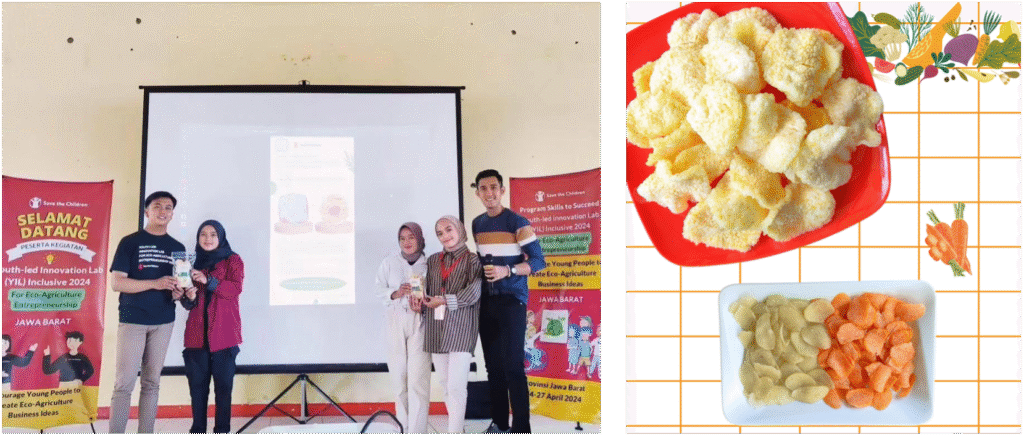
The Problem and Motivation Behind
“So much of the food we grow goes to waste. Why not turn it into something healthy and delicious instead?” Ricky.
Ricky Wildan (18-year-old) grew up in an agricultural community in Indonesia where farmers often discarded vegetables simply because they looked imperfect and could not be sold in the market, known as grade B vegetables. They might not be visually appealing, but they are still perfectly edible ones. This was particularly evident during festive seasons when villagers traditionally used these grade B vegetables to make vegetable crackers for personal consumption, but they never considered their commercial potential.
Inspired by these observations, Ricky and his team chose to address food waste, promote healthy eating habits, and create sustainable economic opportunities for youth and farmers in his community.
The Innovative Solution
“Our crackers are not just tasty; they help the environment and support local farmers.” Ricky.
When Ricky and his team joined the Youth Innovation Lab, they saw an opportunity to transform their local surplus vegetables that would otherwise go to waste into nutritious and sustainable snacks. They developed Vegetable Crackers—a sustainable and healthy snack made from surplus vegetables. Their vegetable crackers not only directly tackle food waste, but it also provides local communities with a healthier snack alternative compared to many market options that are high in fat, salt, and preservatives. Their crackers can also create additional income opportunities for farmers by adding value to previously discarded produce.
Ricky and his team made samples of their crackers and tested how the local markets react to their products, focusing on housewives and youth as primary consumers. The feedback was positive, especially regarding the taste and quality, but some found the price a bit high. Ricky explained that the higher cost was due to the quality ingredients and premium packaging. Ricky adds “They told us that if we market our crackers in tourist areas, they might be better accepted because visitors appreciate quality and unique local products.”. Therefore, their business model strategically targets tourism areas, local markets, and health-conscious communities—markets that appreciate and pay premium prices for sustainable snacks.
Accordingly, they designed a prototype for the production process as follows:
- Sourcing and Preparation: Collect surplus vegetables from local farmers.
- Processing: Blend the vegetables into a batter and fry them into crispy crackers.
- Packaging: Use paper bags instead of plastic to maintain environmental responsibility.
- Distribution: Target local markets, tourist spots, and health-conscious consumers.
“The Innovation Lab helped us plan better and think about how to reach our target market. We learned to present our idea confidently and understand our competitors.” — Ricky
The Youth Innovation Lab supported Ricky and his team to learn how to plan and develop their business. The lab provided mentorship in market testing, financial strategy, and green business practices. This training helped them understand how to highlight the unique value of their crackers and identify suitable consumer segments and markets.
Lessons Learned from Addressing Challenges
- Adjusting target market to overcome pricing challenges: Initially, consumers in local markets found the crackers expensive due to high-quality ingredients and sustainable packaging. To overcome this, Ricky strategically shifted the target market towards tourism hotspots, where consumers readily value premium-quality sustainable snacks. “We realised that selling in local markets might not work, but tourists appreciate quality products. That’s where we’re focusing now,” Ricky explains.
- Expanding the working Team to balance studies and business: Balancing university studies and managing the business became challenging for Ricky. He addressed this by inviting unemployed friends from his village to join his team, which helped share responsibilities and eased the workload.
- Learning from customer feedback: Ricky’s team continually sought feedback from customers and used this information to adjust product pricing and packaging. This flexible approach helped them better meet market needs and increased product appeal
Next Steps and Future Aspirations
“We hope that in the future, Vegetable Crackers will be available all over Indonesia as a healthy and sustainable snack choice,” Ricky concludes.
Ricky envisions Vegetable Crackers becoming a nationwide sustainable snack brand in Indonesia. His clear and ambitious goals include:
- Reaching New Markets: Selling crackers widely across tourist locations, online platforms, and specialty health stores.
- Scaling Production: Expanding capacity to produce crackers more sustainably.
- Supporting More Farmers: Increasing partnerships with local farmers to turn more surplus vegetables into valuable products.
- Introducing New Products: Exploring other vegetable-based snacks and additional eco-friendly food innovations.